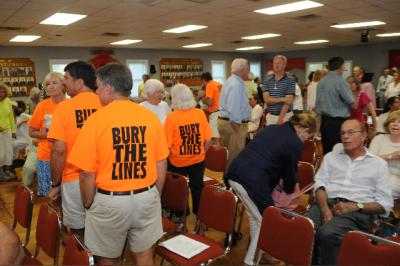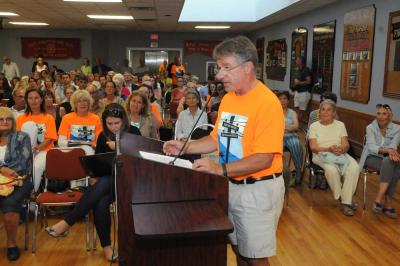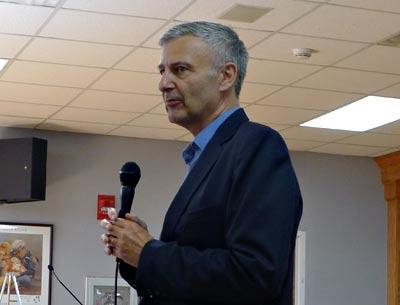High Tension as PSEG Hears From East Hampton
High Tension as PSEG Hears From East Hampton

Julia Bovey, the director of the New York State Department of Public Service’s Long Island office, got some thanks on Tuesday night for responding to calls for an East Hampton hearing on PSEG-Long Island’s long-range plan — and then she got an earful.
During an almost four-hour session at the village’s Emergency Services Building, speakers provided Ms. Bovey with plenty of food for thought. Her office will be compiling comments and recommendations on PSEG’s Utility 2.0 plan and advising the Long Island Power Authority board about whether it should be approved.
Virtually to a speaker, the comments were critical, either of the utility’s future plans or of the actions it has already taken here.
PSEG, which at the start of this year took over operation of Long Island’s power grid from LIPA, has run roughshod over local codes protecting the environment and aesthetics, speakers said. Many objected that its plan lacks specifics about the $294 million it has proposed for projects on the South Fork to meet future energy demand and reduce peak demand. Transparent and open communication, with local involvement in decision-making, is needed, residents and officials agreed. Some called an element of the plan that would increase renewable energy sources but also build new power plants using fossil fuels, backward-thinking, rather than forward.
Tuesday’s meeting in East Hampton and another that day in Riverhead were the last of five public hearings on the plan. Written comments can be submitted by email until midnight Sunday to [email protected], or by phone to a Department of Public Service opinion line, 800-335-2120. A copy of Utility 2.0 is on the department’s website at dps.ny.gov, through the Search by Case Number section; its number is 14-01299.
Once the comment period has ended, the Department of Public Service will send recommendations to PSEG and to the LIPA board, which must approve a final draft. Completion is targeted for early December.
The plan has several elements, a PSEG representative said at the meeting. They include improving the resiliency of the present system, introducing energy-efficiency measures to reduce current demand while meeting projected future demand, and increasing the use of renewable energy by expanding solar, geothermal, and, potentially, wind energy programs. Company-sponsored initiatives to control peak energy use — for example, providing homeowners with programmable thermostats that can be controlled from afar by PSEG and suspending air conditioning for short periods during high-demand days — would be less expensive for PSEG than having to build new power plants, the representative said.
Those filling the room to capacity included a contingent from the group Save East Hampton, wearing bright orange shirts proclaiming “Bury the Lines,” and members of Long Island Businesses for Responsible Energy, LIBFRE, a group that has sued PSEG over the transmission line installation. Rebecca Singer of that group recapped members’ concerns about the toxicity of pentachlorophenol, which coats the new utility poles.
Members of Save East Hampton reiterated their concerns about the tall poles and lines, installed between a power substation on Buell Lane in East Hampton Village and another on Old Stone Highway in Amagansett. Several described fires on their lawns started by downed low-voltage lines and said that their safety would be even more severely at risk should the 60-foot poles, installed 20 feet from their houses, or the high-voltage lines attached to them come down.
“We need you to fix this mistake now,” said Richard Shilowich of McGuirk Street.
“Why are we talking about overhead lines?” rather than burying the lines, wondered Michael Brown. A PSEG speaker had just asserted that “most of the outages are tree-related.”
“We are demanding that you follow what other developed countries have done all across the planet and bury the lines,” said Helen Mendez.
“There was no planning, no transparency, no resiliency,” said Jeremy Samuelson, who lives along the route and is the executive director of Concerned Citizens of Montauk. “This is what you get,” he said. “You have to come back a year later and eat some crow. This thing is an atrocity; I won’t sugarcoat it for you. The question is, is PSEG going to be our partner in fixing this mess?”
Several local officials made pointed comments at the start of the hearing, urging the utility company to be transparent about its plans for the area and to concentrate on renewable sources to meet growing energy needs.
State Assemblyman Fred W. Thiele Jr., the first speaker, referred to the high-voltage lines’ negative impact on scenic vistas and preserved lands in describing East Hampton residents’ determination to preserve and protect the town’s rural character and quality of life.
Sustained applause followed Supervisor Larry Cantwell’s comment that if PSEG’s plan “calls for $294 million in improvements, why not just take 10 percent of that amount and bury the new overhead lines?”
Mr. Cantwell and others recapped what they called a flawed procedure under LIPA, before the turnover to PSEG, to review and present the high-voltage line plan before it got under way. “There was no public participation in that environmental review process, and we can’t let that happen again,” he said. The blueprint for future utility projects, he said, should include “local input in any capital improvement that might be planned.”
Also lacking in Utility 2.0, Mr. Cantwell said, was development of a stand-alone energy source that could serve Montauk should a storm cut off its access to the mainland.
Mayor Paul Rickenbach echoed Mr. Thiele in calling for a standardized formula to be used by PSEG in decisions about covering the cost of burying electric lines — a key sticking point in the ongoing discussion about placing the East Hampton high-voltage line underground.
Michael Forst called for an independent citizens group to oversee the Long Island utility grid. “The utility monopoly needs to end on Long Island so that we do not continue with these backbreaking utility rates,” he said.
Creating new fossil fuel-burning plants — two are proposed for Montauk, one at Navy Road and another at an undisclosed location, and a third at Buell Lane in East Hampton Village — is counter to East Hampton Town’s recently adopted energy policy, of meeting 100 percent of the town’s electricity needs with renewable energy sources by 2020, said Gordian Raacke, director of Renewable Energy Long Island.
Don Matheson of Springs expressed concern that PSEG was “proposing to spend more money on dinosaur technology.” Barnaby Friedman submitted a letter on behalf of 13 East End organizations, include Group for the East End, the East Hampton Environmental Coalition, and the Surfrider Foundation’s Eastern Long Island chapter, opposing new power plants that use fossil fuels.
The Utility 2.0 plan, said Kathleen Cunningham of the Village Preservation Society, does not take into account potential climate-change impacts, of particular concern, she said, in this “unique geographical area.”
While the state Department of Public Service has regulatory authority over power companies across New York, the arrangement on Long Island is different, Ms. Bovey explained. The department’s Long Island office serves only in an oversight and review capacity to LIPA and PSEG Long Island, said its director.
“You have among the highest [electric] rates in the country,” she told the assembly. “Some people will say the highest, after Hawaii.”







